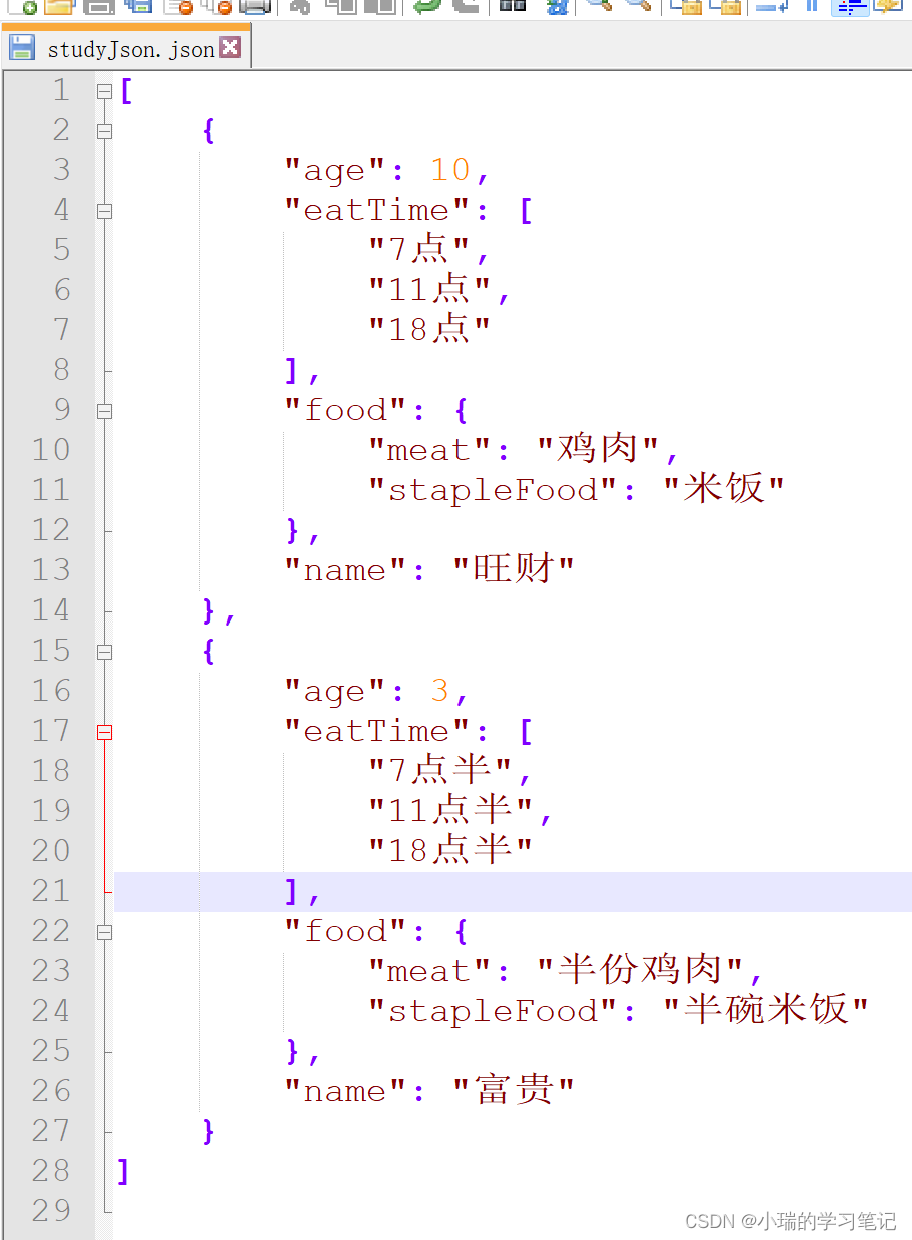文章目录
- Json在Qt中的使用
- 主要使用的类
- QJsonValue
- QJsonObject
- QJsonDocument
- 实战
- 1. 手动写Json文件
- 2. 实现程序(从Json文件中读取数据,更改Json文件中的数据)
Json在Qt中的使用
主要使用的类
| Json 类 | 介绍 |
|---|---|
| QJsonDocument | 它封装了一个完整的 JSON 文档,并且可以从 UTF-8 编码的基于文本的表示以及 Qt 自己的二进制格式读取和写入该文档。 |
| QJsonArray | JSON 数组是一个值列表。可以通过从数组中插入和删除 QJsonValue 来操作该列表。 |
| QJsonObject | JSON 对象是键值对的列表,其中键是唯一的字符串,值由 QJsonValue 表示。 |
| QJsonValue | 该类封装了 JSON 支持的数据类型。 |
QJsonValue
在 Qt 中 QJsonValue 可以封装的基础数据类型有六种(和 Json 支持的类型一致),分别为:
- 布尔类型:QJsonValue::Bool
- 浮点类型(包括整形): QJsonValue::Double
- 字符串类型: QJsonValue::String
- Json 数组类型: QJsonValue::Array
- Json 对象类型:QJsonValue::Object
- 空值类型: QJsonValue::Null
这些类型可以通过 QJsonValue 的构造函数被封装为一个类对象:
// Json对象
QJsonValue(const QJsonObject &o);
// Json数组
QJsonValue(const QJsonArray &a);
// 字符串
QJsonValue(const char *s);
QJsonValue(QLatin1String s);
QJsonValue(const QString &s);
// 整形 and 浮点型
QJsonValue(qint64 v);
QJsonValue(int v);
QJsonValue(double v);
// 布尔类型
QJsonValue(bool b);
// 空值类型
QJsonValue(QJsonValue::Type type = Null);
如果我们得到一个 QJsonValue 对象,如何判断内部封装的到底是什么类型的数据呢?这时候就需要调用相关的判断函数了,具体如下:
// 是否是Json数组
bool isArray() const;
// 是否是Json对象
bool isObject() const;
// 是否是布尔类型
bool isBool() const;
// 是否是浮点类型(整形也是通过该函数判断)
bool isDouble() const;
// 是否是空值类型
bool isNull() const;
// 是否是字符串类型
bool isString() const;
// 是否是未定义类型(无法识别的类型)
bool isUndefined() const;
通过判断函数得到对象内部数据的实际类型之后,如果有需求就可以再次将其转换为对应的基础数据类型,对应的 API 函数如下:
// 转换为Json数组
QJsonArray toArray(const QJsonArray &defaultValue) const;
QJsonArray toArray() const;
// 转换为布尔类型
bool toBool(bool defaultValue = false) const;
// 转换为浮点类型
double toDouble(double defaultValue = 0) const;
// 转换为整形
int toInt(int defaultValue = 0) const;
// 转换为Json对象
QJsonObject toObject(const QJsonObject &defaultValue) const;
QJsonObject toObject() const;
// 转换为字符串类型
QString toString() const;
QString toString(const QString &defaultValue) const;
QJsonObject
QJsonObject 封装了 Json 中的对象,在里边可以存储多个键值对,为了方便操作,键值为字符串类型,值为 QJsonValue 类型。
- 如何创建空的 Json 对象
QJsonObject::QJsonObject(); // 构造空对象
- 将键值对添加到空对象中
iterator QJsonObject::insert(const QString &key, const QJsonValue &value);
- 获取对象中键值对个数
int QJsonObject::count() const;
int QJsonObject::size() const;
int QJsonObject::length() const;
- 通过 key 得到 value
QJsonValue QJsonObject::value(const QString &key) const; // utf8
QJsonValue QJsonObject::value(QLatin1String key) const; // 字符串不支持中文
QJsonValue QJsonObject::operator[](const QString &key) const;
QJsonValue QJsonObject::operator[](QLatin1String key) const;
- 删除键值对
void QJsonObject::remove(const QString &key);
QJsonValue QJsonObject::take(const QString &key); // 返回key对应的value值
- 通过 key 进行查找
iterator QJsonObject::find(const QString &key);
bool QJsonObject::contains(const QString &key) const;
遍历,方式有三种:
- 使用相关的迭代器函数
- 使用 [] 的方式遍历,类似于遍历数组,[] 中是键值
- 先得到对象中所有的键值,在遍历键值列表,通过 key 得到 value 值
QStringList QJsonObject::keys() const;
QJsonDocument
- 它封装了一个完整的
JSON文档,并且可以从 UTF-8 编码的基于文本的表示以及 Qt 自己的二进制格式读取和写入该文档。 QJsonObject和QJsonArray这两个对象中的数据是不能直接转换为字符串类型的,如果要进行数据传输或者数据的持久化,操作的都是字符串类型而不是QJsonObject或者QJsonArray类型,我们需要通过一个Json文档类进行二者之间的转换。
下面依次介绍一下这两个转换流程应该如何操作:
1. QJsonObject 或者 QJsonArray ===> 字符串
- 创建 QJsonDocument 对象
QJsonDocument::QJsonDocument(const QJsonObject &object);
QJsonDocument::QJsonDocument(const QJsonArray &array);
- 将文件对象中的数据进行序列化
// 二进制格式的json字符串
QByteArray QJsonDocument::toBinaryData() const;
// 文本格式
QByteArray QJsonDocument::toJson(JsonFormat format = Indented) const;
- 使用得到的字符串进行数据传输,或者磁盘文件持久化
2. 字符串 ===> QJsonObject 或者 QJsonArray
- 将得到的 Json 格式字符串通过 QJsonDocument 类的静态函数转换为 QJsonDocument 类对象
[static] QJsonDocument QJsonDocument::fromBinaryData(const QByteArray &data, DataValidation validation = Validate);
// 参数文件格式的json字符串
[static] QJsonDocument QJsonDocument::fromJson(const QByteArray &json, QJsonParseError *error = Q_NULLPTR);
- 将文档对象转换为 json 数组 / 对象
// 判断文档对象中存储的数据是不是数组
bool QJsonDocument::isArray() const;
// 判断文档对象中存储的数据是不是json对象
bool QJsonDocument::isObject() const// 文档对象中的数据转换为json对象
QJsonObject QJsonDocument::object() const;
// 文档对象中的数据转换为json数组
QJsonArray QJsonDocument::array() const;
- 通过调用 QJsonArray , QJsonObject 类提供的 API 读出存储在对象中的数据。
实战
1. 手动写Json文件

2. 实现程序(从Json文件中读取数据,更改Json文件中的数据)
mainwindow.h
class MainWindow : public QMainWindow
{Q_OBJECT
public:explicit MainWindow(QWidget *parent = 0);~MainWindow();QVector<struct Animal> readJson();// 读取Json文件bool changeDate();// 改变Json文件中的数据private:Ui::MainWindow *ui;
};
struct Food{QString stapleFood;QString meat;
};
struct Animal{QString name;int age;QVector<QString> eatTimeArr;struct Food food;
};
mainwindow.cpp
MainWindow::MainWindow(QWidget *parent) :QMainWindow(parent),ui(new Ui::MainWindow)
{ui->setupUi(this);changeDate();readJson();
}MainWindow::~MainWindow()
{delete ui;
}// 增加数据直接在手动修改Json文件// 查数据(已知Json数据格式的情况下):将Json中所有animal类保存到vector中全部返回
QVector<struct Animal> MainWindow::readJson()
{QFile file("D:\\Qt\\homework\\text01\\studyJson.json");bool ret = file.open(QFile::ReadOnly);QByteArray bytes = file.readAll();// 把文件中所有数据读取出来QJsonDocument doc = QJsonDocument::fromJson(bytes);// 将读出的数据保存为Json文档QJsonArray groupArr = doc.array();// 获取数组QVector<struct Animal> ans;// 用于保存获取到的数据for(int i = 0; i < groupArr.size(); i++){QJsonObject obj = groupArr.at(i).toObject();// 把数组中每一个数据都转化为 QJsonObjectstruct Animal animal;animal.name = obj.value("name").toString();animal.age = obj.value("age").toInt();// eatTime 对应的值为一个数组QJsonArray foodArr = obj.value("eatTime").toArray();for(int i = 0; i < foodArr.size(); i++){animal.eatTimeArr.push_back(foodArr.at(i).toString());}// food 对应的值为一个 QJsonObject 类型QJsonObject subObj = obj.value("food").toObject();animal.food.stapleFood = subObj.value("stapleFood").toString();animal.food.meat = subObj.value("meat").toString();ans.push_back(animal);// 将获取到的数据加入容器中qDebug() << "name =" << animal.name<< "age =" << animal.age<< "eatTime =" << animal.eatTimeArr[0] << animal.eatTimeArr[1] << animal.eatTimeArr[2]<< "food.stapleFood =" << animal.food.stapleFood<< "food.meat =" << animal.food.meat;}return ans;
}// 改数据:从studyJson.json读取数据并且富贵的年龄改为10岁
bool MainWindow::changeDate()
{// 打开文件QFile file("D:\\Qt\\homework\\text01\\studyJson.json");file.open(QIODevice::ReadWrite);QByteArray bytes = file.readAll();// 读取文件所有内容file.close();QJsonDocument doc = QJsonDocument::fromJson(bytes);// 将读出的数据保存为Json文档QJsonArray groupArr = doc.array();// 获取数组QJsonObject obj = groupArr.at(0).toObject();// 获取数组中第一个元素// 判断 "age"节点是否存在if(obj.contains("age")){obj["age"] = 10;// 将数组第一个元素中的年龄改变// 此时我们新建一个数组,把更新好的元素加入数组,并且把之前数组中没有改变的元素加入QJsonArray arr;arr.append(obj);arr.append(groupArr.at(1).toObject());// 保存至Json文档 注意:调用setArray后,先会把之前保存所有的数据清除,然后再保存新的数据doc.setArray(arr);}// 把最新数据写入QIODevice::Truncatefile.open(QFile::WriteOnly|QFile::Truncate);file.seek(0);// 使写入位置为起始位置file.write(doc.toJson());
}
打印调试信息

执行changeDate()后,Json文件改变

本文链接:https://my.lmcjl.com/post/1906.html
展开阅读全文

4 评论